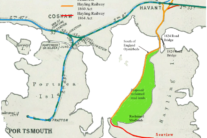The political climate had changed and as a result, the drive to create satellites to the Port of London had diminished. The objective of creating a goods railway onto Hayling had sunk with the crumbling embankments. It really seemed that the Hayling venture was a complete failure. A change of direction was needed if the branch line to Hayling was ever to be completed.
Francis Fuller visited Hayling Island on holiday and recognised its potential as a resort. He purchased building land and to add to the attractions on the island, had plans to construct a horse race track on South Hayling (on the seaward side of Norfolk Crescent and the Royal Hotel). Recognising that good transport links were required, he involved himself with the troubled railway.
He had the potential routes surveyed and found that a route along the west coast of the island would be quicker and less costly to build than the current route on an embankment. It would also now better serve tourism and the local population with the terminus being in West Town giving the branch line a new and tangible purpose.
He became a Director of the Hayling Railway Company in 1866 and purchased the land required in readiness to bring a Bill to Parliament to abandon the embankment route and replace it with the new route.

A notice, advising the intention of placing an application before Parliament to implement the above, was published, 27th November 1866, in the London Gazette. Without waiting for the authority in the form of an Act of Parliament, He instructed that the railway was built in accordance with the Bill. He wanted the railway to be opened in time for the first race meeting at his own horse race course at South Hayling.

Triggs Guide 1867 Race programe Day 1
Construction
The line was completed swiftly highlighting the folly of the original scheme. The first train carrying passengers traversed the line on 28th June 1867. This was a private train, run to convey the Contractor, Francis Fuller and friends. Public usage had to wait until authorised by the Railway Inspector from the Board of Trade.
The Board of Trade Inspection
This took place on 4th July 1867. The inspector found it puzzling that the whole branch line was being offered for inspection when the first section (Havant to Langstone) was already authorised for operation and the southern section was still before Parliament as a Bill seeking deviation from the original route.
The inspection revealed, amongst other things, the following issues:-
- Havant – Langstone section. Signalling, track and track layout problems were identified. The level crossing at Langstone was also found to be unauthorised.
- Langstone to South Hayling Terminus, Alterations had been made to the bridge without submitting these changes to the Board of Trade. Incomplete fencing, damaged rails and some rotten sleepers were found on the southern section.
Needless to say the line failed the Inspection.
The outstanding Act of Parliament was approved on 12th August 1867.
The inspector returned on 15th August and found that considerable work had been done to correct some of the issues raised. This was sufficient for him to allow the line to open although he recommended a speed limit of 20mph. The level crossing was never authorised and this remained the case until the line closed in 1963.
The delay in approval meant that the first day of the races was not supported by a train service from Havant.






You must log in to post a comment. Log in now.